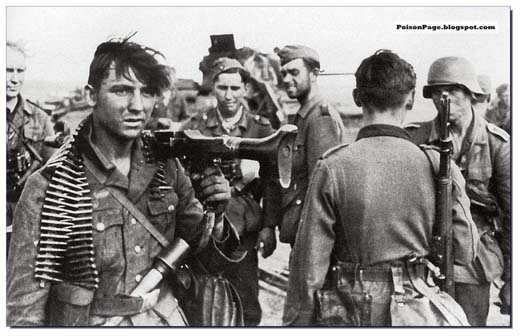Air Operations, Europe
BOMBER COMMANDDaylight Ops:
- 4 Mosquitos to Hannover, Braunweiler and Cologne
- 3 aircraft bomb, results unknown
- 1 aircraft lost
Air Operations, Greece
USAMEAF B-24s attack the Corinth Canal.
[Air Operations, Mediterranean
12th Medium Bomb Group B-25s attack Axis shipping at sea and Axis landing grounds.
[Air Operations, New Guinea
5th Air Force P-40s destroy 7 Japanese Navy landing barges beached at Goodenough Island in the D'Entrecasteaux Islands stranding a Japanese Army landing force and thwarting an invasion attempt against the Allied base at Milne Bay. In another operation, 5th Air Force B-17s, based in Australia, supported by RAAF P-40s, attack a Japanese convoy bound for Milne Bay from New Ireland and damage 1 transport. Bad weather keeps the air attack from turning back the convoy, and 1,200 Japanese Army troops are put ashore at 3 different locations near Rabi, New Guinea.
[Air Operations, Solomons
In action between 0230 anf 0400 hours, 3 VSMB-232 SBDs and 3 Flight 300 SBDs attempt to locate and attack Japanese Navy transports north of Guadalcanal. The Marines fail to find targets and the Navy pilots miss Japanese warships they do find near Savo Island.
2 VMF-223 F4Fs down a Japanese Navy four-engine reconnaissance bomber near Malaita Island during a morning patrol and 2 VMSB-232 gunners each down a Japanese Navy reconnaissance float plane off Guadalcanal, also during morning patrols.
About 1015 hours, 8 11th Heavy Bomb Group B-17s based at Espiritu Santo attack a sinking transport and a rescue destroyer. As many as 5 direct hits sink the destroyer. Late in the day, B-17s attack the bomb-damaged Japanese seaplane carrier Chitose and her escorts, but no hits are recorded.
[Battle of the Eastern Solomons
US army and navy bombers attack the Japanese transports carrying reinforcements to Guadalcanal and force them to turn back. 2 are damaged and a destroyer is sunk by American aircraft. The Japanese now recognize the difficulty of daylight operations because of Henderson Field's aircraft, and for the moment, revert to using fast destroyers to bring in supplies during the night.
[Britain, Home Front
HRH The Duke of Kent, younger brother of King George VI, a serving officer in the RAF, is killed in a plane crash near Wick in the north of Scotland. He had waived his honorary rank of RAF marshal and was an air commodore serving as chief welfare officer of the RAF Home Command. He was en route from England to Iceland in bad weather. The rear gunner of the Sunderland flying boat is the only survivor.
[Diplomatic Relations
The Swedish SS Gripsholm arrives in New York with 287 Alled officials and their families who had been exchanged for Japanese diplomats at Lourenço Marques in Portuguese East Africa, now Mozambique.
[Eastern Front
There is heavy fighting along the Terek River in the Caucasus particularly around Mozdok as the Germans repulse a Russian counterattack. The Germans now head for Grozny and Baku in the Crimea.
The Stalingrad Communist Party Committee proclaims a state of siege: 'We shall never surrender the city of our birth; every house of every street is to be transformed into an impregnable fortress.'[MORE]
Germans on the Bank of the Volga |
 |
Gilbert Islands
The Japanese occupy Nauru.
[Guadalcanal
An assessment of the Cactus Air Force on this date shows: of the 19 F4Fs flown in from Long Island (AVG-1), 5 have been destroyed and 3 are inoperable waiting for parts; of the 12 five bombers, only 9 are operational. 10 Enterprise (CV-6) bombers are also present at the moment.
[New Guinea
The Japanese occupy Goodenough Island in the D'Entrecasteaux Islands, near the southeast coast of New Guinea. Their 7 lighters were actually headed for Milne Bay, but lost their way. They are destroyed by American aircraft. During the night the Japanese land without opposition east of Rabi, on Milne Bay. They are attempting to occupy land suitable for a Japanese forward air base to support the army's drive on Port Moresby. As they advance westwards they are fiercely resisted by the Australian and American garrison.
[Pacific
- The US submarine Growler (SS-215) sinks the Japanese gunboat Senyo Maru (2904t) 20 miles south of Takao, Formosa.
- The US submarine Seawolf (SS-197 sinks the Japanese cargo ship Showa Maru (1349t) off the northeast coast of Borneo.